In 1999 NASA lost its $125-million Mars Climate Orbiter because spacecraft engineers failed to convert from Imperial to metric measurements when exchanging vital data before the craft was launched. Numbers are important!
When Michael Le Page attempts to sort out the numbers in climate science (probably pay-walled) it’s not as straight forward as you might think. For starters we are given this image:
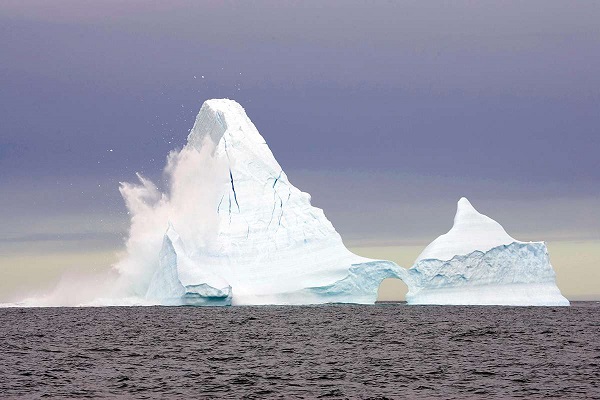
Sorry, when floating ice melts the sea level does not rise. The caption is misleading.
We’ve had a lot of different numbers going around, which has confused people, even climate scientists:
-
Climate change deniers seize on the uncertainty as evidence that the underlying science is wrong. It’s not. It is just complex, as messy, real-world science is.
How much has the planet warmed already?
In 2015 the Paris agreement decided to keep temperature increases to 1.5°C above pre-industrial levels. Depending on which numbers we use, we might have as much as 0.6°C still to go before we cross the threshold – or less than 0.3°C.
The troubles begin with how we measure the temperature. Le Page says ‘mean global surface temperature’ usually refers to the heat of the air 2 metres above the surface. I could have sworn it was 1.2 metres.
When I asked Dr Google, it was 2 metres definitely, but in the first batch of articles we were told 2 metres, 1.2 metres, 1.25 metres, 5 feet and 6 feet. Our Bureau of Meteorology says 1.2 metres. In the UK the Met Office says 1.25 metres.
The standard seems to be to use the Stevenson Screen, shown here by BOM:
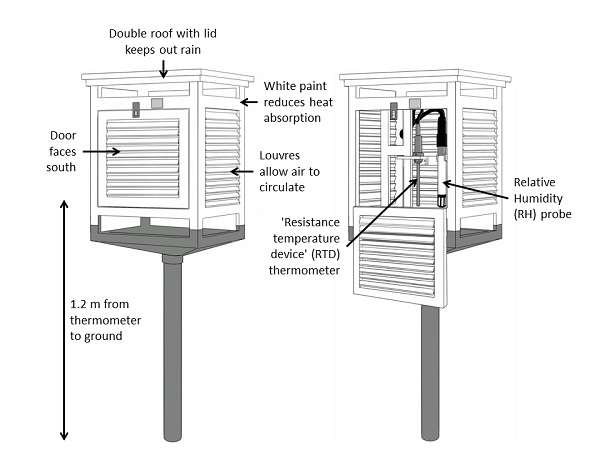
If you google the image, in context they look about 1.2 to 1.25 rather than 2 metres. Not sure it matters, but ground level would be up to several degrees hotter. I think they strive for consistency over time at each station.
More important is this:
- The HadCRUT temperature record, maintained by the UK’s Met Office, simply leaves the Arctic out. NASA’s GISTEMP record estimates Arctic temperatures based on surrounding stations. Because the Arctic is rapidly heating up, NASA’s figures suggest there has been nearly 0.1°C more warming across the planet than the Met Office’s do.
However, there is also disagreement about the pre-industrial base, which is not defined. There were no reliable records before 1850, so HadCRUT takes the starting point as 1850 to 1900. NASA takes into account computer models which indicate that the industrial era had caused a further 0.2°C of warming before 1850. So NASA puts current warming at 1.2°C, while HadCRUT puts it at 0.9°C.
This article points out that if you take the higher figure there is 40% less “allowable emissions” left, meaning less ‘burnable carbon’.
I think it is already too hot, which means there is no burnable carbon. I prefer James Hansen’s presentation (see rationale here), which is based on NASA GISS numbers. Here’s the graph updated to 17 Dec 2018:
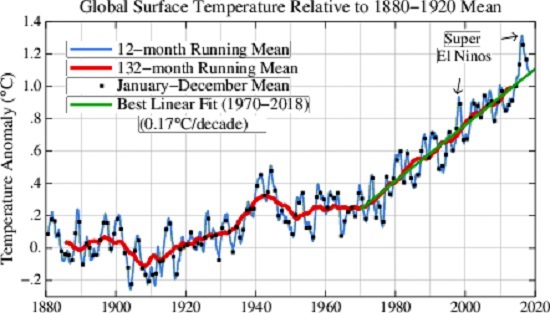
The 132-month running mean puts temperature rise at about 1.0°C. We are currently above the trend line, and well above the 132-month running mean, which has been rising consistently since about 1970.
What is the safe limit for warming?
- Not 1.5°C. That was picked not because it is the right number, but because it was convenient. A 1990 report concluded that limiting global warming to 1°C would be safer than a 2°C cap. But in 1996, with 1°C already looking out of reach, 2°C was adopted as a target by the European Union’s Council of ministers. This led to its 2010 adoption by the UN.
In other words the 2°C cap was never based on science. See my 2014 post Two degrees. The notion of 2°C was started with a suggestion by William Nordhaus, a Yale economics professor, in 1975. The “1990 report” was by the Stockholm Environment Institute, which said:
- “Temperature increases beyond 1.0°C may elicit rapid, unpredictable, and non-linear responses that could lead to extensive ecosystem damage,” the report said, suggesting there is nothing necessarily ‘safe’ about a two degree limit. (Emphasis added)
Le Page says the recent IPCC report has said much the same. What kept them for 18 years? All this time we have been told that 2°C was the guardrail to keep the climate safe.
Here I’ll add a graph adapted by David Spratt from Young People’s Burden: Requirement of Negative CO2 Emissions (2016) by James Hansen et al.:
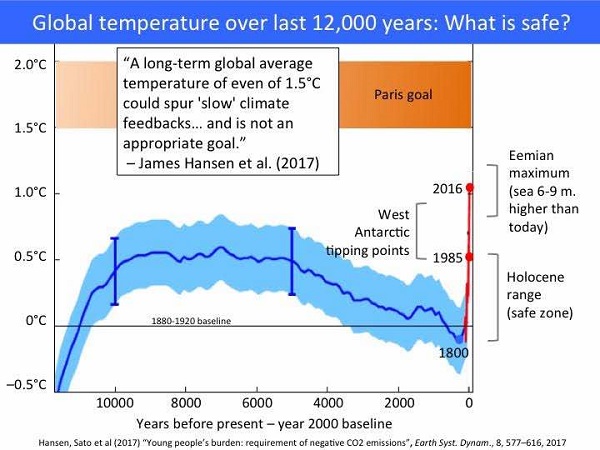
We left the ‘safe’ Holocene zone about 30 years ago.
When are we set to pass the 1.5°C limit?
The first year over 1.5°C will probably happen in the 2020s, according to Le Page, but you need an average over a longer period to make the call scientifically. The article talks about that coming in 2040 or thereabouts, along with concern about overruns and irreversible tipping points.
How much warming does CO2 cause?
Le Page says this is “perhaps the toughest question in all of climate science.” CO2 warms the atmosphere directly but not by much. It also increases the water vapour content of the atmosphere, which is a powerful greenhouse agent. Other effects such as changes to the ice sheets take thousands of years. I’ve addressed these issues a number of times. See Reconciling estimates of climate sensitivity and Quiggin on climate risk.
Le Page says that studies of climate sensitivity, that is, how much warming would occur in the decades and centuries after a doubling of CO2 levels, “converge on the most likely value being 3°C, but with plausible values ranging from under 2°C to more than 5°C.” This graph comes from the IPCC AR4 report published in 2007:
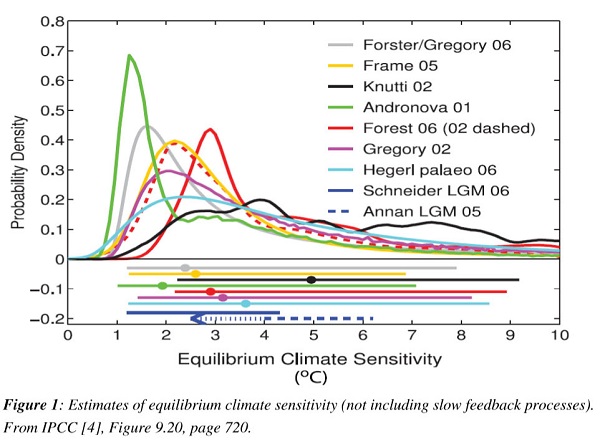
Please note that the graphs do not include slow feedbacks. Here’s a table from page 17 of Hansen’s 2011 paper Earth’s Energy Imbalance and Implications where he gives four categories of climate sensitivity:
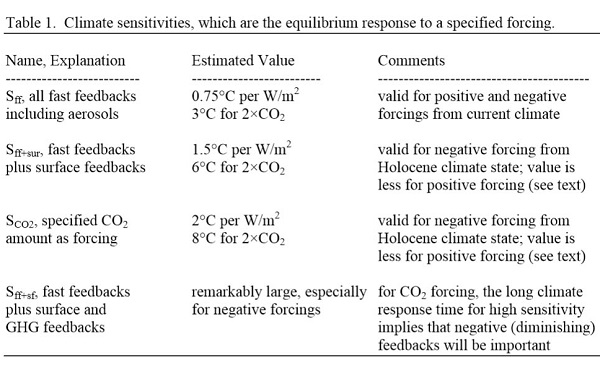
I find it strange and indeed unacceptable that his paper seems to be ignored.
Le Page ends this section with:
While we are increasingly confident that the low end of the plausible range can be ruled out, there is a long tail of high values that cannot. Earlier this year, some climate scientists warned that we could be greatly underestimating the risks, and that if the planet did warm by at least 2°C, it might be impossible to stop it warming several further degrees.
The link is to his August 2018 article Global warming may become unstoppable even if we stick to Paris target, which begins:
We could be on the verge of triggering a series of cascading tipping points that result in the planet warming 4 or 5°C hotter than the pre-industrial benchmark.
That, at least, is the view of a group of 16 climate scientists, who have spelled out a scenario in which sea levels would be 10 to 60 metres higher than today. This warming would continue even if we ceased pumping CO2 into the atmosphere – and the threshold could be as low as 2°C.
There Le Page was writing about the so-called ‘hothouse earth’ article which went viral in August. Here’s a post at the Climate News Network Hothouse earth could soon be unavoidable, a media release from the Stockholm Resilience Centre and the paper itself by Will Steffen et al Trajectories of the Earth System in the Anthropocene. This figure is key:
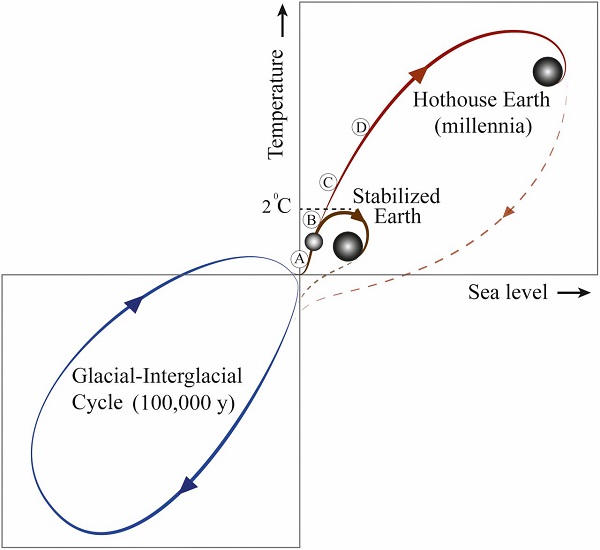
We are at “B”, showing again that we’ve left the Holocence, and the pattern of ice ages with warming interglacials which prevailed for about 3 million years. It should be understood that there is no new science in this article. They’ve done an excellent job in identifying and summarising the most relevant science, and putting the implications in a risk context. It’s sharper and more urgent than the IPCCC 1.5°C report.
Steffen et al say there is a threshold beyond which warming becomes uncontrollable by human action, taking us into a zone which would threaten human civilisation and take millennia to rectify. While they don’t know where the threshold is they suggest it could occur at a temperature rise as low as ∼2.0 °C above pre-industrial, but it could also be within the range of the Paris Accord temperature targets.
-
Avoiding this threshold by creating a Stabilized Earth pathway can only be achieved and maintained by a coordinated, deliberate effort by human societies to manage our relationship with the rest of the Earth System, recognizing that humanity is an integral, interacting component of the system. Humanity is now facing the need for critical decisions and actions that could influence our future for centuries, if not millennia (88).
And:
- The Stabilized Earth trajectory requires deliberate management of humanity’s relationship with the rest of the Earth System if the world is to avoid crossing a planetary threshold. We suggest that a deep transformation based on a fundamental reorientation of human values, equity, behavior, institutions, economies, and technologies is required. Even so, the pathway toward Stabilized Earth will involve considerable changes to the structure and functioning of the Earth System, suggesting that resilience-building strategies be given much higher priority than at present in decision making.
One of the authors of the article is Hans Joachim Schellnhuber. He is founding director and now Director Emeritus of the Potsdam Institute for Climate Impact Research (PIK) and a Member of the German Advisory Council on Global Change (WBGU) advising the German government. Like Hansen, when he speaks everyone should listen.
How much more CO2 can we emit?
From the above, the answer should clearly be, none. However, Le Page quotes the IPCC 1.5°C report, saying that to stay within 1.5°C the budget could be as low as 258 gigatonnes or as high as 570, depending on which temperature numbers you use (see above). However, Le Page says:
- Even these numbers conceal huge uncertainty. The budgets could be 650 gigatonnes lower or higher, depending on climate sensitivity and the historical baseline, meaning we might already have exceeded even the biggest budget. In addition, the report says, if wetlands release more methane and melting permafrost releases more carbon than assumed, the budgets would be 100 gigatonnes lower.
Reports now usually include overshoot, or what Glen Peters of the Center for International Climate Research in Norway calls “exceedance budgets”.
- These set out how much CO2 we can emit up to the point the temperature rise passes 1.5°C. If you were doing a bungee jump, this would be equivalent to the length of rope with which you would exactly smash into the ground.
So:
- “Once you allow negative emissions, the carbon budget is an ill-defined concept,” says Peters.
Confused? It’s not just you. “Everyone is confused,” says Peters.
They shouldn’t be. Hansen told them in 2007 that we needed to get back to 350ppm of CO2 in the atmosphere, assuming the other greenhouse gases were net zero. I think CO2 was about 385 ppm at the time, so we were already in overshoot.
On 5 June 2014 in a post The game is up I cited David Spratt who told it straight:
- We have to come to terms with two key facts: practically speaking, there is no longer a “carbon budget” for burning fossil fuels while still achieving a two-degree Celsius (2°C) future; and the 2°C cap is now known to be dangerously too high.(My bold)
How high will the seas rise?
Le Page:
During the warm period between ice ages about 120,000 years ago, temperatures were around 1°C warmer than from 1850 to 1900, and sea level was 6 to 9 metres higher. In other words, even if we limited warming to 1.5°C, much of the ice in Greenland and West Antarctica could still be lost, which would be enough to raise sea levels 5 metres or more.
Without a change of course, we are actually heading for a world that is 3 or 4°C warmer, which could lead to seas rising more than 20 metres. The huge unknown is how long this will take. Because the planet’s temperature is increasing much faster now than it did in any recent warm periods, the past is not a good guide to our immediate future.
Then:
The prevailing view is that it will take many centuries or millennia. IPCC projections are for sea levels to go up by between 0.3 and 0.8 metres by 2100 in a world that is 1.5°C warmer, and by 0.5 to 1 metre by the end of the century if emissions keep increasing unchecked. If it stays warm, there will be bigger sea level rises in the 22nd century and beyond.
Some scientists regard these projections as conservative. Antarctica is already losing ice much faster than expected, and a 2016 study based on a computer model of its ice sheets suggests the seas could rise by up to 3 metres by 2100.
The report by David Spratt and Ian Dunlop What lies beneath: the understatement of existential climate risk talks about the continued inadequacy of the IPCC approach to sea level rise. This graph comes from a 2006 paper:
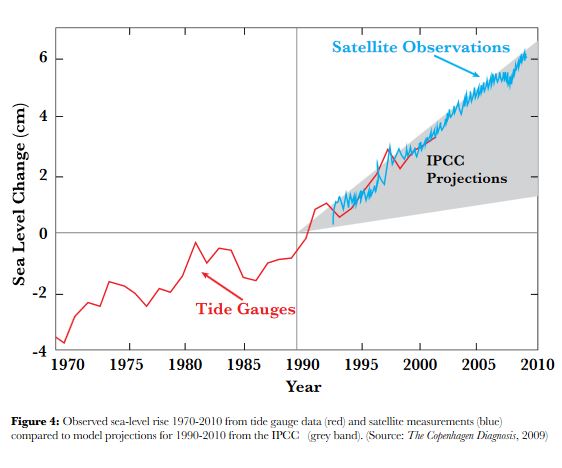
Since then they’ve gotten worse. From What lies beneath:
- An updated NOAA sea-level rise report, released in August 2017, recommends a revised worst-case sea-level rise scenario of 2.5 metres by 2100, 5.5 metres by 2150 and 9.7 metres by 2200. It says sea-level science has “advanced significantly over the last few years, especially (for) land-based ice sheets in Greenland and Antarctica under global warming”, and hence the “correspondingly larger range of possible 21st century rise in sea level than previously thought”.
In one sense it’s pretty simple. From the last glacial maximum 22,000 years ago until the Holocene, sea level rise increased 120 metres with a 5 or 6°C temperature increase, giving an average rate of about 20 metres per degree. If the temperature goes up a further 5°C, sea level will rise a further 75 metres or so, with an average of around 15 metres per degree. Ice sheet decay has started in earnest in Greenland and West Antarctica. Sea level rise is picking up speed. This is from Hansen’s Climate Change in a Nutshell: The Gathering Storm (December 2018):
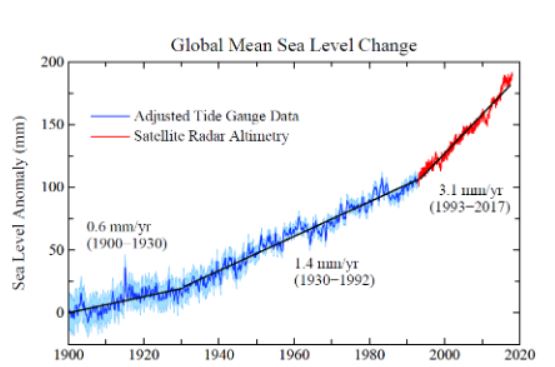
That’s looking suspiciously like a rapidly steepening curve.
In response to the IPCC 1.5°C report I’ve said that we should be focussing on CO2 concentrations in the atmosphere rather than temperature. During the Eemian, when SLR was 6-9 metres, CO2 levels were about 300ppm. When the levels were last where they are now, during the early Pliocene several million years ago, we had SLR of 25m (±5).
As to how rapidly things could go pear-shaped, coming out of the last ice age about 14,000 years ago the seas rose about one metre every 20 years for 400 years in an event called Meltwater Pulse 1A:
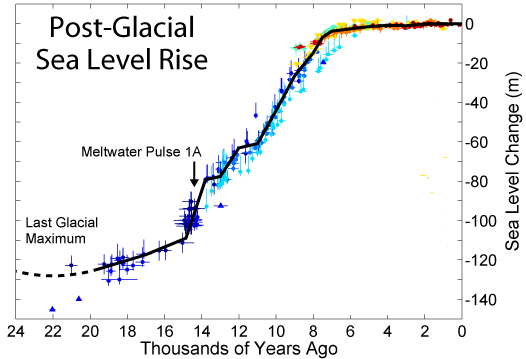
While there was more ice then to melt than there is now, climate change was then driven by orbital changes. Now climate change is being driven harder now, probably 20 times harder, or more. We are in new territory for the planet, so the future is inherently uncertain.
This image is from Hansen’s Nutshell paper:
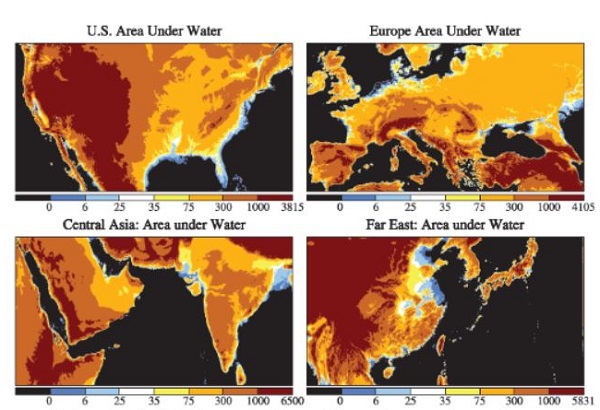
Light blue is 0-6 metres, dark blue 6-25 metres. River deltas like the Ganges in Bangladesh and India, and the Mekong in Vietnam will be in the front line. Hansen says 11 of the large cities on the East Coast of the United States, including Boston, New York, Philadelphia, Washington, Miami, would become dysfunctional and abandoned. The Chinese would lose 100 million or more in the northern food-growing area. Not so easy to see, the Pearl River Delta opposite Hong Kong has a population of about 57 million. Much of it is about a metre above sea level.
See also Scoping long-term sea level rise.
How long do we have to turn things around?
Le Page says:
-
“Scientists Say We Have 12 Years to Save the World.” That is the message many seem to have taken from the latest IPCC report – but that is not quite what the report says.
We have to begin immediately to act at scale, he says..
Amid the morass of confusing and conflicting numbers, two things remain crystal clear. First, we have to reduce net global emissions to zero, and the faster we do it the better off we will all be. Second, how bad things get partly depends on how much we do to prepare. We need to get serious about adapting to life on a warmer planet.
That link is to a New Scientist article Bill Gates leads global call to accept realities of a warming planet.
Prof Hans Joachim Schellnhuber, in introducing What lies beneath told us not be too hard on the IPCC. Scientists are doing the best they can in difficult circumstances:
-
But climate change is now reaching the end-game, where very soon humanity must choose between taking unprecedented action, or accepting that it has been left too late and bear the consequences.
Therefore, it is all the more important to listen to non-mainstream voices who do understand the issues and are less hesitant to cry wolf.
Unfortunately for us, the wolf may already be in the house.
(Emphasis added)Update: From Hansen’s Climate change in a nutshell, more than half the world’s largest cities are on the coastline:
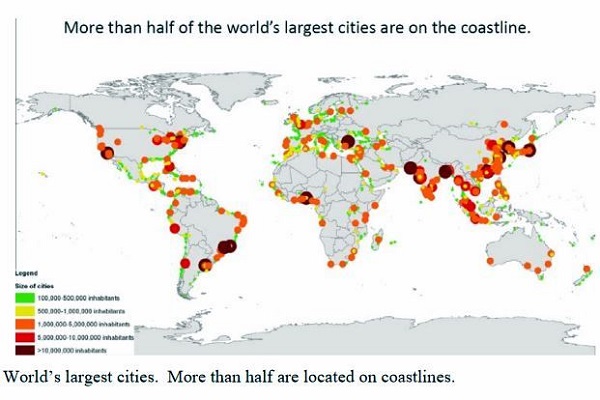

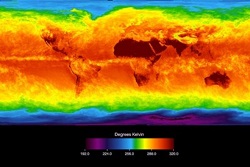
Posted yesterday morning in the SMH by Nicole Hasham is an article headlined The stunning chart revealing Australia’s record-breaking run of rising temperatures. It includes a few graphs from the BOM:
– Australian mean temperature anomaly (1910 – 2018)
– Australia’s rainfall in 2018
– Maximum temperatures 2018
– Mean temperatures 2018
Geoff M, I plan to do a post on that report as it contains important information on the whole planet.
I’ve posted an update:
From Hansen’s Climate change in a nutshell, more than half the world’s largest cities are on the coastline:
Brian:
Fact check time?
Was careful to get an upper floor unit in our latest move so that the only difference a sea level rise will make is that it will allow me to moor my boat to the balcony rail.
John, I’ve made it “the Ganges in Bangladesh and India. Seems it’s some India.
Can’t imagine how Sri Lanka got into my head.